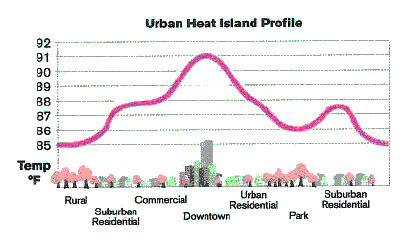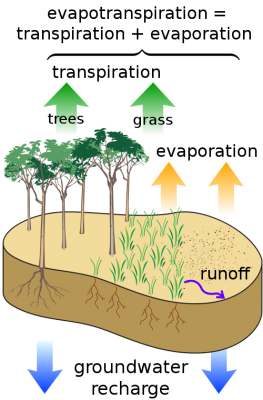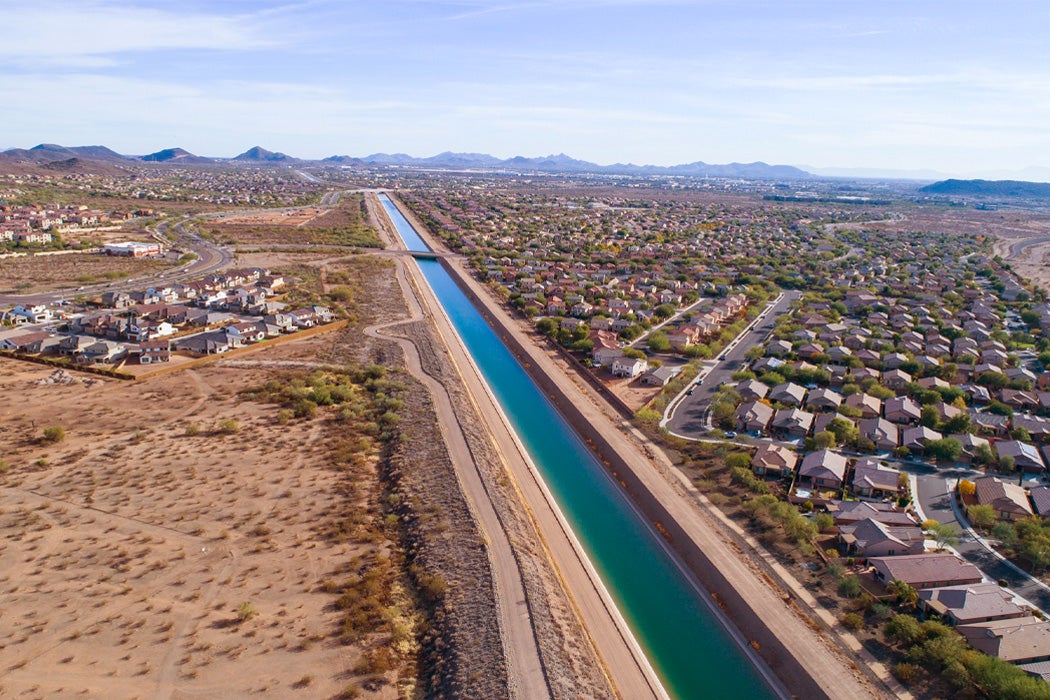Record breaking heat is a common phenomenon in desert cities like Phoenix and Tucson. During the summer, temperatures often skyrocket to 110 degrees or more, and with climate change, the research models predict an average increase of 4 to 10 degrees in the Southwest region. A rise in temperatures coupled with population growth—Phoenix, the 5th largest city in the United States, is home to approximately 1.6 million people and while Tucson has over 535,000—calls into question the long-term sustainability of desert cities.
The factors that affect sustainability in Phoenix and Tucson are the increasing likelihood and severity of drought conditions, the concrete buildings burgeoning in an urban sprawl, and the so-called heat island effect in which urban temperatures spike higher than they do in the surrounding rural areas—think above 98 degrees at night in summer. And then there is the distinct possibility that water sources will dry up.
Arizona’s history with water is complicated. In 1968, President Lyndon B. Johnson greenlighted the Central Arizona Project, a canal that spans 336 miles in length carrying water from the Colorado River to different parts of the state. The chief concern, according to Kathryn Sorensen, director of Phoenix Water Services, is that the “Colorado River is overallocated and the basin is experiencing 20 years of drought.” She adds that “in the coming decades the flow of the river may diminish as much as 25 percent in the future,” jeopardizing one of the state’s main sources of water.

However, Ladd Keith, assistant professor in planning and chair of the Sustainable Built Environments program at the University of Arizona, takes the challenges of water conservation in the desert head on. “In many ways, Phoenix and Tucson are on the cutting edge of sustainability because they were forced to confront water scarcity decades ago,” he says. “The Southwest is fertile ground to create solutions.”
Some of these solutions are working. Although Phoenix has grown by over 400,000 people, the water usage is the same as it was 20 years ago, Sorensen says. “We have basically decoupled growth from water use.”
The evolution of water conservation and sustainability in desert environments is a result of a multi-prong approach: rethinking city planning, efficient water use and shifting perspectives.
Rethinking City Planning: Assessing the Urban Heat Island Map
Rethinking city planning is a key way for desert cities to approach water scarcity especially since the city growth rate is increasing more rapidly in Arizona than in other places. Part of this influx is due to affordable housing, lower taxes, educational institutions, and temperate weather. “The population of desert regions is growing at an 18.5 percent faster rate compared to those in other ecological zones,” says Keith. “Aquifers are still depleting and as a result of climate change there will be less winter precipitation to feed the Colorado River. In the future, we will see more droughts.” Given this context, it is essential for communities to rethink city planning and water use.
That requires looking at the urban heat island map of a particular city. The urban heat island impact (UHI) focuses on what causes a certain metropolitan area to have a higher temperature than its surrounding rural areas. At night, cities cool off less due to the heat absorbed during the day in the built environment, including buildings, streets, and parking lots. There is also a dense traffic of people in urban areas, all of whom emit heat, which also increases the UHI. Rural areas have a lower UHI because they are less populated, have more green areas, and fewer buildings.

For scientists, mapping urban heat islands takes concentrated effort. Satellite images track hot and cool temperature zones in a particular place to help developers make better city planning decisions. Researchers are also measuring whether the temperature measurements from the satellite correlate to what people are feeling on the ground and their thermal comfort. Correlating information from the satellites and data collection, which includes measuring people’s experienced thermal comfort, can help urban planners make informed decisions related to on site design,” says Keith. The factors that increase or lower an urban heat island depend on the type of building materials used, cars, and the amount of vegetation. Lighter colors, green roofs, clay, and straw minimize the impact on the landscape and help lower temperature, while lack of vegetation and darker-colored materials tend to increase it. Keith’s research looks at how planners use UHI maps from satellite data in Southwest cities such as Phoenix, Tucson, Albuquerque, and Las Cruces to see how future development can reduce a particular area’s UHI. This data helps urban planners devise more cool spaces in an urban sprawl. Keith says other metropolises like New York and Miami, are interested in learning lessons from the Southwest cities to better deal with their recent heat waves.
Conserving Water
Tucson has a strong water conservation ethos. It has to. The city is at the end of the Central Arizona Project, the last one in line to receive the precious water from the Colorado River. It also has a higher per capita of environmental nonprofits than other places in the United States and the presence of University of Arizona, which helps push conservation efforts. In order to increase vegetation and act on the data shown in the urban heat map, the Tucson Electric Company has a tree planting program and residents receive water rebates for passive water harvesting—a practice of letting water collect and soak into the ground, as well as installing gutters and cisterns to accumulate rainwater. A nonprofit organization named Watershed Management Group trains neighborhood volunteers in passive water harvesting that allows homeowners to make a “sponge” out of their land—a practice equally useful for flood zones and arid climates. . Homeowners in the desert can collect water that falls on their property and use it for their needs. Rooftop water is funneled into rain barrels or diverted into the soil.
Efficient Water Use
Faced with water scarcity, Tucson and Phoenix excel at conservation campaigns, wastewater recycling that allows that water to be used again, and aquifer recharge—natural and manmade processes that convey water underground. Phoenix in particular has a long tradition of thoughtful, proactive planning for water needs. First, there is an active campaign to protect underground water reserves, called fossil aquifers, from being overused. Second, water users experiencing deficit in their water supply can borrow from the individuals who have a surplus. There is a fee for this exchange, which is called water banking, but it allows managing water demands more efficiently. Lastly, Phoenix Water fosters a culture of wise water use through education outreach. “It also structures its water rates to clearly signal the scarcity rates in the desert, which gives residents a direct economic incentive to conserve our most precious resource,” Sorensen says.

Tucson also puts a lot of effort into water conservation. Sharon B. Megdal, director of the University of Arizona Water Resources Center and a professor of water and environmental science, says that surface and groundwater are combined in their usage to minimize the environmental, physical, and economical impact. Like Phoenix, Tucson also uses aquifer recharge. Tucson uses it as a treatment option for taking surface water, letting it infiltrate, mixing it with ambient groundwater, and then pulling that mixed water for delivery to its customers. Megdal emphasizes, “it is also a way to store water underground for future use and it isn’t subject to evaporation.”
Reclaimed water plays an important part in efficient use—water that isn’t drinkable can be used as a source in outdoor areas. “Phoenix and Tucson has had success in using irrigation in ballparks, golf courses, and cemeteries,” Medgal says. “There is also a culture of matching the water quality to the intended use. Outdoor watering doesn’t need potable quality water and so regulations can be more relaxed.” Matching water needs based on the specific use paves the way for conservation and better utilization of resources.
Weekly Newsletter
“Tucson and Phoenix have long-term messaging about water conservation and it is very much a part of life,” says Medgal. Sorensen adds that “rather than focusing on the short-term, reactive restrictions during drought conditions, Phoenix Water emphasizes long-term culture change.”
Cities outside the desert facing water scarcity see the advantage of having a balanced water portfolio. This means evaluating and balancing the supply from various water sources—storm water, surface water, recycled water, groundwater, greywater—and then allocating it for intended uses, while fostering a culture of conservation.
A Shift in Perspective
There is a measurable shift in perspective in Phoenix when it comes to water usage. “We reclaim and reuse our wastewater, water consumption rates have fallen dramatically, and we work collaboratively with other cities, Native American communities, irrigation districts, and other stakeholders to ensure a sustainable water future,” Sorensen says. This is a result of a pro-conservation culture built in Phoenix. “Water conservation should be a cultural value and lifestyle, not a reaction to hydrologic events.” There is an active encouragement for people to use water wisely and there is a direct incentive to convert from landscapes that require a large amount of water during the summer to plants and flora that require little or no irrigation. The numbers prove that Phoenix has embraced an efficient landscape. “In the 1970’s, approximately 80 percent of single-family residence had majority of grass or lush landscaping. Today, that number is only 10 percent.”
Implementing this change in other cities across the country might take time, but Phoenix and Tucson portray how a slow, gradual shift in the underlying philosophy can result in a comprehensive, measurable change. “Picking on Phoenix in terms of sustainability is a popular sport, but our advantage in the face of climate change is that Phoenicians understand the value of water in the desert and support investment in the infrastructure that brings certainty,” Sorensen says. “Desert cities are the oldest cities and they will stand the test of time.”







